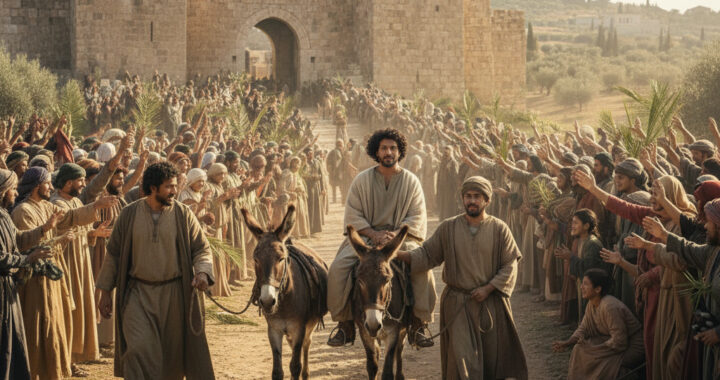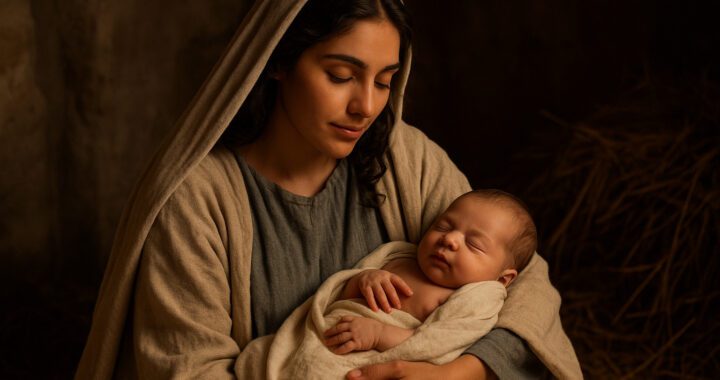The thrilling Christmas event of the eternal Creator God becoming man will always be shrouded in mystery. Paul, in reciting perhaps an early Christian hymn, expressed the event thusly: “And without controversy great is the mystery of godliness: God was manifest in the flesh” (1 Tim. 3:16a).
Other mysteries in connection with the incarnation have excited interested saints since the first Christmas day. The identity of the magi and the appearance of a mysterious star have perplexed sincere minds for the past two millennia.
The Evangelist Matthew relates that at the time of the nativity of the Lord there came wise men (magi) from the East to Jerusalem to inquire after the newly-born King of the Jews. They related to King Herod their intentions to offer the royal infant presents and to worship Him. The star which they had seen in the East guided them to the house where the infant Messiah was. There they presented Him with gifts of gold, frankincense and myrrh.
I. The Mystery of the Star
To explain the mysterious star, various natural and supernatural theories have been offered and some have given up hope of ever determining the nature of the star.
A. Naturalistic Explanations:
- The famous astronomer Kepler (d. 1630) first suggested that in 7 B.C. there occurred a conjunction of the planets Jupiter and Saturn in the zodiacal constellation of Pisces, a sign sometimes connected by ancient astrology to the Hebrews.
- Kepler himself preferred the view that this was a supernova-a faint star that violently explodes and over a period of time gives off enormous amounts of light in an erratic fashion.
- Others have suggested comets, such as Halley’s Comet which passed overhead in 12 B.C. However, among the ancients a comet was rarely considered a good omen.
- Robert H. Gundry, though claiming to be an evangelical, sees Matthew as inventing the entire account of the magi following the star by turning Luke’s account of the visit by the shepherds into a theological tale of the wise men from the East (Matthew A Commentary on His Literary and Theological Art, 26).
B. The Agnostic Position:
A number of scholars despair of coming to any certain conclusion concerning the mysterious star.
- Hendriksen concludes thusly: “We are left in the dark, and should intend no further explanation as to the identity of this astral phenomenon” (Matthew, 153).
- Even Foerster, in the prestigious Kittel’s Theological Dictionary of the New Testament similarly resigns, “Yet we still cannot be sure what the wise men saw or are reported to have seen, or how to interpret it astrologically.” (I, 505).
C. The Supernatural Position:
Arnold Fruchtenbaum comes to the conclusion that the star was no regular astral body:
That this is no ordinary star is evident by the actions that this star took. For one think, the star led them from the east to the west; secondly, it led them from the north to the south; thirdly, the star stood over the very house where Jesus was, and fourthly, it was “his” star in a sense that is not true of any other star (The Footsteps of the Messiah, 422).
One might further observe that the star appeared, disappeared, and then appeared again, hardly the characteristics of an astral body.
What was the spectacular star? The word star (aster) “is used generally of any luminous, nonterrestrial body other than the sun and moon’ (Douglas, New Bible Dictionary, 1214). In the New Testament the words aster and astron are used 28 times, but only in five cases does the word describe an ordinary literal star. The idea of a brilliant light at the birth of the Savior, called “his star” (Mt. 2:2) which prompted the wise men to search out the Savior and brought them ‘exceeding great joy” (Mt. 2:10) suggests that a supernatural phenomenon is described. The purpose of the star, says White, ‘was to authenticate and publicize the incarnation and to draw men to worship the celestial king. The many speculations about the aspects of the star and the frequent searches for a mechanistic explanation violate the very purpose of the gospel narrative” (Tenney [ed.], The Zondervan Pictorial Encyclopedia of the Bible, V, 513).
It appears that the star, or, literally, the radiance or brilliance, was the Shechinah Glory of God, that is, the visible manifestation of His presence. The Shechinah Glory (from shachan, or dwelling) is the glory of God by which He manifests His presence to men. In Genesis 15:12–18 God’s luminous presence appears to Abraham at the sealing of the covenant. Later the Shechinah Glory appeared to Moses at the burning bush (Ex. 3:1–5). It led the Israelites in the form of a pillar of a cloud and a pillar of fire through the desert (Ex. 14:19–26). It appeared to Moses at Mount Sinai (Ex. 34:5–9), descended on the tabernacle (Ex. 29:42–46), and later filled the Solomonic Temple (1 Ki. 8:10–13). When Israel fell into apostasy the Shechinah Glory reluctantly left the Temple in four stages and departed eastward (Ezek. 9:3; 10:4, 18-19; 11:22,23) and disappeared from Jewish history. ICHABOD. The glory had departed.
Then suddenly, centuries later, wise men in the East, the direction in which the glory had departed, witnessed its reappearance, guiding these Gentiles to the incarnate deity in Bethlehem. This resplendent manifestation of the presence of God was witnessed earlier by the shepherds near Bethlehem: “The glory of the Lord shone round about them: and they were sore afraid” (Lk. 2:8,9). The “star’ of Bethlehem was thus a spectacular sign to Jews and Gentiles alike that God was once again in their midst. (For a detailed discussion of the Shechinah Glory see Fruchtenbaum, 409–432.)
II. The Magic of the Star
Matthew describes the star in language most likely alluding to Numbers 24:17: “I see him but not now; I behold him, but not nigh. There shall come forth a star out of Jacob, and a sceptre shall rise out of Israel.” This oracle, spoken by Balaam who came ‘from the eastern mountains (Num. 23:7) uttered a beautifully suggestive prophecy of Christ’s ultimate appearance to Israel as the ruler over the world, rescuing the nation from spiritual darkness.
The question has often been asked whether Balaam’s prophecy of a star out of Jacob and sceptre out of Israel has any connection with Messiah’s star which the magi saw. Dr. Unger suggests an interesting relationship between Balaam’s prophecy and the wise men:
It seems perfectly reasonable to suppose that this great Messianic prophecy had been preserved in Mesopotamia, whence Balaam came, and may with further divine revelations, have furnished the core of truth upon which the Magi acted. It is certainly a pleasing thought that these devout Gentiles had treasured and meditated upon a prophecy given by one who may well have been a member of a priestly order allied to themselves. These noble ‘wise men from the East’ assuredly had lived up to the light they had, and found themselves recipients of more light, even the brilliant lustre of a luminous star shining through the darkness and leading them to worship Him Who was born King of the Jews’ (Matt. 2:3)” (Starlit Paths for Pilgrim Feet, 142).
The magic of the star drew the magi to Israel. As wise men they sought the Savior; they sought Him until they found Him, and once they found Him they worshipped and adored Him, presenting themselves and their gifts to Him.
III. The Message of the Star
The lowly Jewish shepherds and the lofty Gentile sages witnessed the glory of Him who was “born in the city of David, a Savior which is Christ the Lord.” God granted the shepherds and the wise men, the despised among the Jews and the strangers from the covenants and promises, to witness Messiah’s star. The religious leaders of Israel would not travel six miles from Jerusalem to Bethlehem to greet the God-man, yet strangers from the East traveled innumerable miles of inhospitable terrain to follow the divine light to the feet of the One whom they recognized as the “Star out of Jacob.”
As Unger stresses, it behooves us all to respond in a similar fashion to the Savior of the world:
Oh, for a similar faith that will make us wise, like them, to discern the splendid glory and luminous loveliness of the Son of God and Savior of the world, and to seek Him until we find Him, and having found Him yield our all to Him in holy service and sacrifice (Starlit Paths for Pilgrim Feet, 144).
In the light of the star
Lie the ages impearled,
And the song from afar
Has swept over the world.
Every heart is aflame,
And the beautiful sing,
In the homes of the nations
That Jesus is King!
We rejoice in the light,
And we echo the song
That comes down through the night
From the heavenly throng.
Ay! we shout to the lovely
Evangel they bring,
And we greet in His cradle
Our Savior and King!
Josiah G. Holland

Dr. Manfred Kober
Dr. Manfred Kober (Th.M. and Th.D., Dallas Theological Seminary) is a German-born theologian and educator who has significantly contributed to Christian scholarship and ministry. After enduring the hardships of post-war Germany, he emigrated to the United States in 1953. Dr. Kober pursued theological studies at Baptist Bible Seminary in Johnson City, New York, the University of Erlangen in Germany, and Dallas Theological Seminary.
He served as a professor and chaired the Department of Theology at Faith Baptist Bible College in Ankeny, Iowa, from 1969 to 1999. Today, he resides in Bondurant, IA, with his wife, Sharon, and they have two children and three grandchildren.

